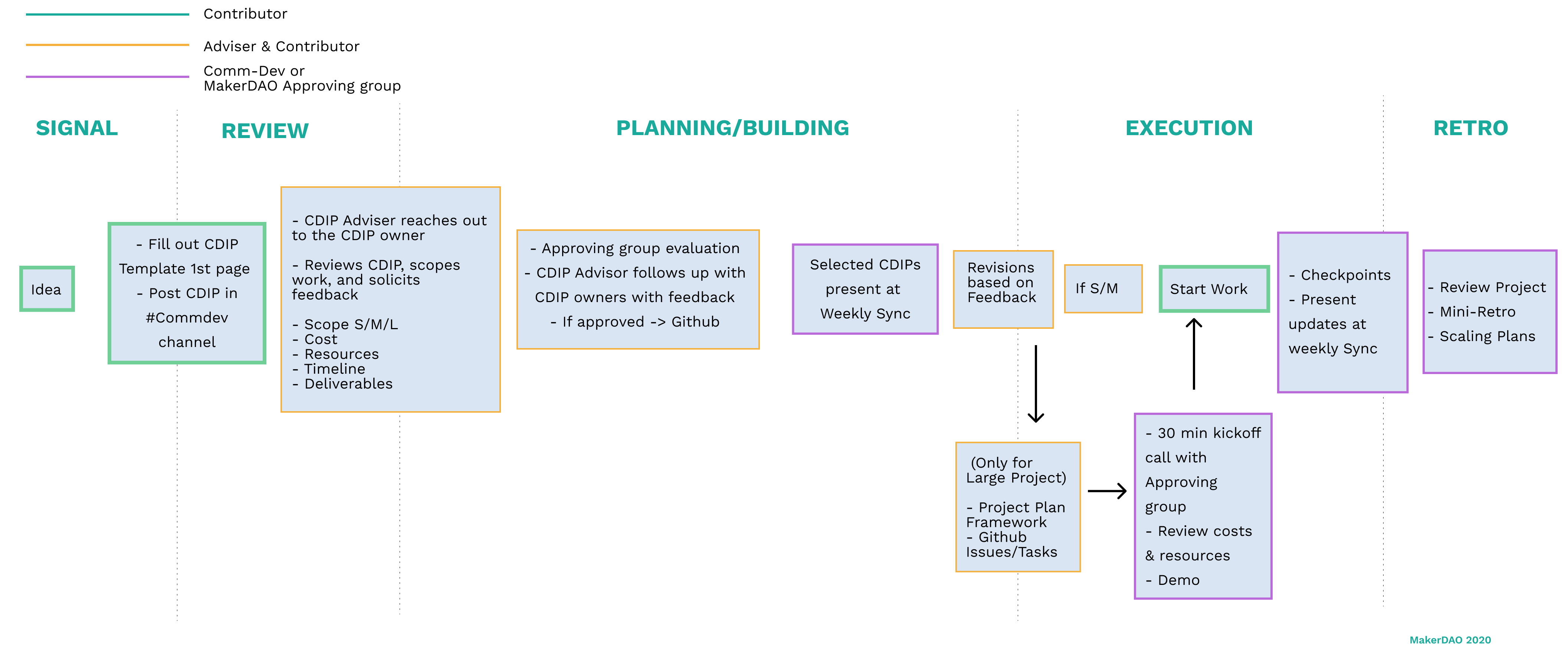The CDIP Process
Here’s an outline of how self-directed projects move from idea to approval to completed. We've added some helpful resources to get you started.
At a high level, below is a visual representation of the current process.
- Green: Proposal Owner
- Purple: Approving Group
- Orange: Both

Roles
There are many roles involved in growing a community project from idea to reality.
- Proposal Owner: Creator of the proposal and the driver of the project. Leads meetings and communication, sets contributor roles, goals, timelines, and expectations.
- Contributing Team: Contributes responsibilities or expertise to the owner, or lead
- Advisor: Supportive role that can help scope, follow up, brainstorm, test, and keep Community Development abreast of communications and project updates.
- Approving Group: Evaluators reviewing and approving proposals. A mix of Maker Foundation employees and seasoned contributors of the community.
Process
1
Write a Proposal From Our Template
A proposal should combine the suggested ideas and skills to improve resources for the MakerDAO community. Use this Google Doc template to structure the proposal so that information is clear and milestones are defined.
Open Proposal Template2
Post Your Proposal in Our Chat
Post your proposal in our Community-Development Chat.
3
Engage With Feedback
An Advisor will reach out to help you through the next steps.
The Approving Group will reach out to the proposal owner and provide feedback. You’ll work on the scope, budget, resources, and timeline.
4
Wait for a Decision
An Approving Group meets weekly to review proposals. They will stay in touch for regular updates.
The Approving Group discusses which proposals will get funding and which need more clarification. We’ll reach out to any proposal owners with the next steps and any comments.
5
Start Work
If it’s a small or medium scoped project, and you’ve addressed any feedback, work can begin.
For large projects, split proposals into GitHub issues/tasks. Another call with the approving group is needed to confirm the costs and resources.
6
Communicate Progress
All projects will have checkpoints. You should expect to present progress at Community weekly sync meetings.
7
Evaluate at a Retrospective
Upon completion, there is a review process. Share the work and discuss what went well, as well as what can be improved.
If you are unsure about your proposal, post your idea in the chat for feedback. An Advisor will help you iterate on your project.
DO
DON'T
Community Resources
Here’s a list of resources useful for executing on your proposal.
Writing Style Guide: How to Write Like a Maker Contributor
Editorial Standards: What to Look Out for When Reviewing Work
Writing Style Guide: How to Look Like Comm-Dev at Maker
Assets and Design Files: Maker's official logos, badges, and product screenshots from the Foundation design team.
Proposal Details
Outline anything you need in your proposal.
- People Support: developers, designers, editors, writers, videographers
- Foundation Resources Support: brand assets, official product screenshots
Let your Advisor know if you need more resources than you anticipated! They'll coordinate a meeting, outline any required resources, and present them to the Approving Group. They’ll figure out whether or not to approve additional resources.
What the CDIP Committee Looks For
- Roadmap: Clear scope, milestones, timeline, and a path to delivery
- Duration: Three months or less
- Budget: Below 5K DAI
- Purpose: Clear impact on community growth, team, operations improvements, or workflow improvements
- Research: Complete research upfront to help the clarity of the plan
Current CDIP Decision Process
- Advisor meeting complete, and table on second page complete
- Committee meets to determine if the impact is clear, and the ROI is defined
- Feedback is shared, if not approved, as well as the next steps for approval.
- Improvements shared and check-ins scheduled, if accepted
- The Advisor adds status updates and tags the GitHub issue
Quick Heuristics and Evaluative Questions
- A simple set of deliverables; one or two items, a presentation, an MVP of a technical product, on a realistic timeline, is best.
- The budget is clear upfront; think defined number for set hours, try to avoid ranges.
- Does the contributor have a portfolio to cross-reference or demonstrate skills relevant to CDIP?
- Are the plans expedient?
Possible Blockers & Ways to Help
- Longer than a three-month timeline
- More than five hours of research is necessary to complete the idea phase. The idea is probably not clear enough.
- Too many web3 interactions or protocol dependencies. A hackathon may be a better format.
Questions
Reach out to us on the community chat if you want to know more about submitting a community project idea.